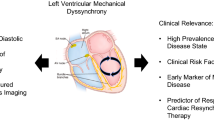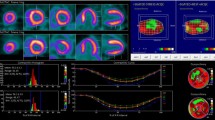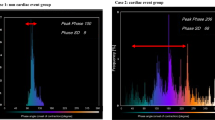Abstract
Background
Assessment of left ventricular mechanical dyssynchrony (LVMD) from gated SPECT myocardial perfusion imaging (MPI) aims to aid selection of patients for cardiac resynchronization therapy (CRT), using either the standard deviation of left ventricular phase (PSD) ≥ 43° or phase histogram bandwidth (HBW) of > 38° and > 30.6° in males and females, respectively. We observed dyssynchrony parameters might be affected by test type and alignment.
Methods
We reviewed 242 patients who underwent gated SPECT MPI with use of the Emory Cardiac Toolbox comparing PSD and HBW at rest and stress for Pearson correlation, and substitutability with Bland–Altman analysis.
Results
There is statistically significant difference in the mean PSD and HBW during rest vs stress (33.4 ± 17.4° vs 20.7 ± 13.5° and 97.7 ± 59.6° vs 59.4 ± 45.4°, respectively, P < 0.001). Proper valve plane alignment rendered smaller values (i.e., less dyssynchrony) in both phase SD and HBW (16.8 ± 13.5) vs (22.2 ± 14.7) (P = 0.011), and (47.0 ± 38.2) vs (60.7 ± 48.0) (P = 0.023), respectively.
Conclusion
Proper alignment and test type, particularly low-dose rest vs high-dose stress, should be considered when assessing LVMD using SPECT MPI.







Similar content being viewed by others
Abbreviations
- LVMD:
-
Left ventricular mechanical dyssynchrony
- CRT:
-
Cardiac resynchronization therapy
- HFpEF:
-
Heart failure with preserved ejection fraction
- SPECT:
-
Single-photon emission computerized tomography
- MPI:
-
Myocardial perfusion imaging
- PSD:
-
Standard deviation of left ventricular phase
- HBW:
-
Histogram bandwidth
- ASNC:
-
American Society of Nuclear Cardiology
- TID:
-
Transient ischemic dilation
- LV:
-
Left ventricle
References
Haghjoo M, et al. Prevalence of mechanical dyssynchrony in heart failure patients with different QRS durations. Pacing Clin Electrophysiol 2007;30:616-22.
Cheng A, Helm RH, Abraham TP. Pathophysiological mechanisms underlying ventricular dyssynchrony. Europace 2009;11:v10-4.
Wang J, et al. Systolic and diastolic dyssynchrony in patients with diastolic heart failure and the effect of medical therapy. J Am Coll Cardiol 2007;49:88-96.
AlJaroudi W, et al. Predictors and incremental prognostic value of left ventricular mechanical dyssynchrony response during stress-gated positron emission tomography in patients with ischemic cardiomyopathy. J Nucl Cardiol 2012;19:958-69.
Goldberg AS, et al. Prognostic value of left ventricular mechanical dyssynchrony by phase analysis in patients with non-ischemic cardiomyopathy with ejection fraction 35-50% and QRS < 150 ms. J Nucl Cardiol 2014;21:57-66.
Bax JJ, et al. Left ventricular dyssynchrony predicts response and prognosis after cardiac resynchronization therapy. J Am Coll Cardiol 2004;44:1834-40.
Marsan NA, et al. Left ventricular dyssynchrony assessed by two three-dimensional imaging modalities: Phase analysis of gated myocardial perfusion SPECT and tri-plane tissue Doppler imaging. Eur J Nucl Med Mol Imaging 2008;35:166-73.
Notabartolo D, et al. Usefulness of the peak velocity difference by tissue Doppler imaging technique as an effective predictor of response to cardiac resynchronization therapy. Am J Cardiol 2004;94:817-20.
Yu CM, et al. A novel tool to assess systolic asynchrony and identify responders of cardiac resynchronization therapy by tissue synchronization imaging. J Am Coll Cardiol 2005;45:677-84.
Sogaard P, et al. Tissue Doppler imaging predicts improved systolic performance and reversed left ventricular remodeling during long-term cardiac resynchronization therapy. J Am Coll Cardiol 2002;40:723-30.
Aljaroudi W, et al. Alternative methods for the assessment of mechanical dyssynchrony using phase analysis of gated single photon emission computed tomography myocardial perfusion imaging. Int J Cardiovasc Imaging 2011;28:1385-94.
Boogers MJ, et al. Optimal left ventricular lead position assessed with phase analysis on gated myocardial perfusion SPECT. Eur J Nucl Med Mol Imaging 2011;38:230-8.
Chen J, et al. SPECT myocardial perfusion imaging for the assessment of left ventricular mechanical dyssynchrony. J Nucl Cardiol 2011;18:685-94.
AlJaroudi W, Jaber WA, Cerqueira MD. Effect of tracer dose on left ventricular mechanical dyssynchrony indices by phase analysis of gated single photon emission computed tomography myocardial perfusion imaging. J Nucl Cardiol 2012;19:63-72.
Samad Z, et al. Prevalence and predictors of mechanical dyssynchrony as defined by phase analysis in patients with left ventricular dysfunction undergoing gated SPECT myocardial perfusion imaging. J Nucl Cardiol 2011;18:24-30.
AlJaroudi W, et al. Impact of left ventricular dyssynchrony by phase analysis on cardiovascular outcomes in patients with end-stage renal disease. J Nucl Cardiol 2010;17:1058-64.
Aljaroudi W, et al. Left ventricular mechanical dyssynchrony by phase analysis of gated single photon emission computed tomography in end-stage renal disease. Am J Cardiol 2010;106:1042-7.
Aljaroudi WA, et al. Relation of left-ventricular dyssynchrony by phase analysis of gated SPECT images and cardiovascular events in patients with implantable cardiac defibrillators. J Nucl Cardiol 2010;17:398-404.
Atchley AE, et al. Use of phase analysis of gated SPECT perfusion imaging to quantify dyssynchrony in patients with mild-to-moderate left ventricular dysfunction. J Nucl Cardiol 2009;16:888-94.
Chen J, et al. Is nuclear imaging a viable alternative technique to assess dyssynchrony? Europace 2008. https://doi.org/10.1093/europace/eun221.
Trimble MA, et al. Evaluation of left ventricular mechanical dyssynchrony as determined by phase analysis of ECG-gated SPECT myocardial perfusion imaging in patients with left ventricular dysfunction and conduction disturbances. J Nucl Cardiol 2007;14:298-307.
Chen J, et al. Onset of left ventricular mechanical contraction as determined by phase analysis of ECG-gated myocardial perfusion SPECT imaging: Development of a diagnostic tool for assessment of cardiac mechanical dyssynchrony. J Nucl Cardiol 2005;12:687-95.
Filho EMS, et al. Are there normal values of phase analysis parameters for left ventricular dyssynchrony in patients with no structural cardiomyopathy? A systematic review. Nucl Med Commun 2019;40:980-5.
Henneman MM, et al. Phase analysis of gated myocardial perfusion single-photon emission computed tomography compared with tissue Doppler imaging for the assessment of left ventricular dyssynchrony. J Am Coll Cardiol 2007;49:1708-14.
Juarez-Orozco LE, et al. Phase analysis of gated PET in the evaluation of mechanical ventricular synchrony: A narrative overview. J Nucl Cardiol 2019;26:1904-13.
van der Veen BJ, et al. Ventricular dyssynchrony assessed by gated myocardial perfusion SPECT using a geometrical approach: A feasibility study. Eur J Nucl Med Mol Imaging 2012;39:421-9.
Zhou Y, et al. Left ventricular dyssynchrony parameters measured by phase analysis of post-stress and resting gated SPECT myocardial perfusion imaging. World J Nucl Med 2013;12:3-7.
Hansen CL, et al. Myocardial perfusion and function: Single photon emission computed tomography. J Nucl Cardiol 2007;14:e39-60.
Henneman MM, et al. Can LV dyssynchrony as assessed with phase analysis on gated myocardial perfusion SPECT predict response to CRT? J Nucl Med 2007;48:1104-11.
Bland JM, Altman DG. Statistical methods for assessing agreement between two methods of clinical measurement. Lancet 1986;1:307-10.
Aljaroudi W, et al. Impact of ischemia on left ventricular dyssynchrony by phase analysis of gated single photon emission computed tomography myocardial perfusion imaging. J Nucl Cardiol 2011;18:36-42.
Li D, et al. Impact of image reconstruction on phase analysis of ECG-gated myocardial perfusion SPECT studies. Nucl Med Commun 2009;30:700-5.
Ryan JJ, et al. Stress-only imaging in patients with prior SPECT MPI: A simulation study. J Nucl Cardiol 2012;19:311-8.
Disclosure
Omaima Ali, Maithili Shenoy, Anas Alani, Maath Alani, and Kim Williams declare that they have no conflict of interest.
Author information
Authors and Affiliations
Corresponding author
Additional information
Publisher's Note
Springer Nature remains neutral with regard to jurisdictional claims in published maps and institutional affiliations.
The authors of this article have provided a PowerPoint file, available for download at SpringerLink, which summarises the contents of the paper and is free for re-use at meetings and presentations. Search for the article DOI on SpringerLink.com.
The authors have also provided an audio summary of the article, which is available to download as ESM, or to listen to via the JNC/ASNC Podcast.
Electronic supplementary material
Below is the link to the electronic supplementary material.
Rights and permissions
About this article
Cite this article
Ali, O., Shenoy, M., Alani, A. et al. Are SPECT MPI measures of dyssynchrony dyssynchronous?. J. Nucl. Cardiol. 28, 1128–1135 (2021). https://doi.org/10.1007/s12350-019-02024-z
Received:
Accepted:
Published:
Issue Date:
DOI: https://doi.org/10.1007/s12350-019-02024-z




